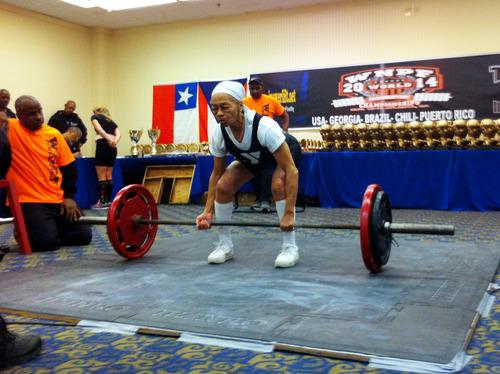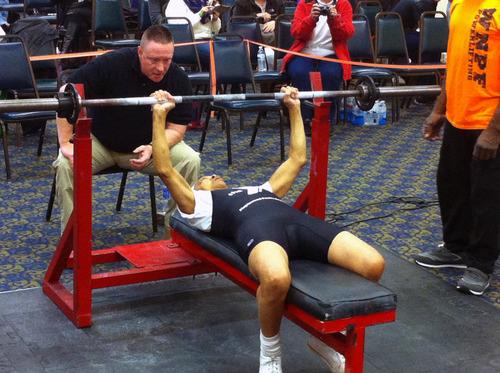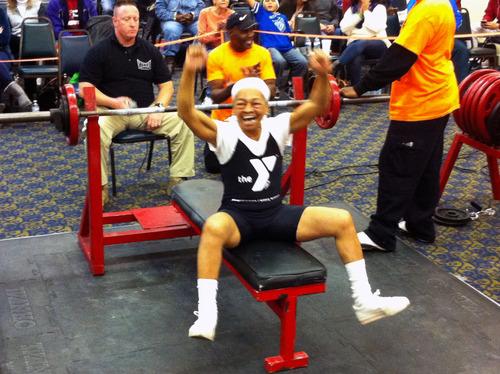
Willie Murphy is redefining what it means to be a senior. Why aren’t more older adults following suit?
In his prime, Arnold
Schwarzenegger could deadlift 710 pounds. Willie Murphy can deadlift 215
pounds — more than a quarter of Arnold’s max. And she’s a 77-year-old grandmother. READ MORE AT THE CUT
At just 105 pounds, Murphy
doesn’t exactly scream “meathead,” but she could probably put most of us
to shame in the gym, cranking out one-handed pushups and pull-ups with
ease, according to USA Today.
It all started with a
weight-lifting competition at her local YMCA in Rochester, New York, a
few years ago. After an employee told her she could compete — “Go for
it, granny” — Murphy began lifting 5-pound weights. Now she’s taking
home trophies: She recently took first place in her division in the
deadlift, power curl, bench press, and bench press repetition
competitions at the WNPF World Championships.
She was also named the World Natural Powerlifting Federation 2014 Lifter of the Year.
Back at her local gym, other
exercisers have started asking to feel her biceps. One woman even called
Murphy her idol. “They see I’m old and I’m not being pushed around in a
wheelchair,” she told USA Today. “I can shovel my own snow. And I can
push my car if it gets stuck in the snow…I’m almost 80 years old and I
am still living life.”
It’s for this very reason that Wayne Phillips, research director for ActiveRx, a
chain of active aging facilities, recommends strength training for
older adults. “There’s sleep and diet and nutrition—all of that’s
important,” he tells Yahoo Health. “But really, the foundation of our
functional life is strength. Strength is the basis of quality of life
and autonomy.” Translation: If you maintain your muscles as you age,
you’ll be able to live independently for longer — that is, you’ll be
shoveling your own sidewalk, just like Murphy.

(Photo: ipowerlift.net)
That’s in addition to all of the
obvious health benefits of lifting weights, which range from improved
mental health to lower blood pressure to stronger bones. Hitting the
bench can also ward off what might seem like inevitable weight gain as
you age: “When you lose muscle, your metabolism slows down,” says Wayne
Westcott, an exercise scientist at Quincy College.
But that doesn’t have to happen
just because you hit 60: “When you start strength training in your 60s,
70s, 80s, even 90s, you will add about one pound of muscle per month,”
Westcott says. Since muscle is your calorie-burning engine, those gains
translate to fat loss — no dieting required.
So why are so few older adults
able to lift even half of what Murphy can? For starters, there’s a
perception that as we age, we should take it easy, which is why walking
has become the favored form of exercise among the elderly, says
Phillips. In fact, past a certain age, people may assume that pumping
iron is ineffective or even dangerous.
But the truth is, you can build
muscle well into your golden years — a time when people are normally
losing 10 to 15 percent of their muscle mass per decade. And it’s
totally safe: “There are no side effects, except you get stronger, your
balance improves, and your quality of life improves,” Phillips says.
Building strength may not require
as much effort as you’d expect, either (unless, of course, you plan to
give Murphy a run for her money). Phillips touts a technique called
“single-set resistance training,” where you perform only one set of
eight to 12 repetitions per exercise. “We know from the research that if
you do one set, you get as much benefit as if you do two or three or
four sets,” he says. At ActiveRx, he prescribes simple routines of only
five or six exercises, totaling about half an hour of gym time.

(Photo: ipowerlift.net)
How many days a week do you need
to commit? Again, it may be fewer than you’d think. “We’ve found for
building muscle and bone two days a week is essentially as good as
three,” says Westcott. However, if you hope to blast fat or lower your
BP, three days a week is ideal. Keep in mind, any more is overkill,
since your body requires recovery time between lifting sessions.
Related: 7 Ways to Get Fit in Half the Time
For safety reasons, the American College of Sports Medicine
recommends machines over barbells and dumbbells for older adults (when
possible). As for the amount you lift, Phillips suggests starting with a
weight that requires a level five out of 10 effort, with 10 being the
absolute most you could lift. Once you’re able to complete 15
repetitions of an exercise, you’re ready to add more weight, says
Westcott.
Try these exercises to target
your major muscle groups for major gains — in and out of the gym. (Hint:
You may want to have a personal trainer demonstrate proper form before
attempting these moves on your own.)
Chest press
As a pushing exercise, the chest
press will lead to noticeable improvements in everyday abilities, such
as opening doors, moving furniture, or pushing a loaded-down shopping
cart, says Phillips. Although a chest-press machine is ideal, you can
also use a resistance band — simply wrap it behind a chair and pull
forward, suggests Westcott.
Leg press
As you age, the speed at which
you walk is a major predictor of how long you’ll live, says Westcott.
“When walking speed starts to decrease, it’s a downhill slide.” You can
hit all of your motoring muscles — quadriceps, glutes, hamstrings, and
hip muscles — with the leg press, which translates to benefits you can
see in daily life. “Legs are the twin pillars of our independence,” says
Phillips. “You need them for practically everything you do — balance,
stairs, getting out of a chair.”
Row
As a pulling exercise, the row
will help you lift heavy objects in daily life. If you don’t have access
to a rowing machine, you can sit on the floor (or on your bed), loop a
resistance band under your feet, and pull it toward your chest, says
Westcott.
Rotary Torso Machine
This rotating exercise
challenges your core, says Westcott, which reduces your odds of low back
pain. “You want to be really strong in that area, because it takes a
lot of twisting, turning, and bending,” he says. “Pretty much everything
we do requires core involvement to stabilize the body.” Although this
exercise has been criticized for being less effective than other core
moves, those requiring bands or free weights are often too difficult for
older adults, he notes.
Comments
Post a Comment
Thanks for commenting